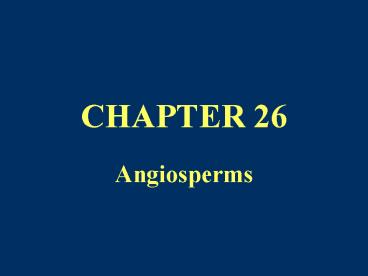Angiosperms PowerPoint PPT Presentation
1 / 11
Title: Angiosperms
1
CHAPTER 26
- Angiosperms
2
What is an Angiosperm?
- Plant that produces flowers, and develops seeds
enclosed in a fruit - Division Anthophyta
- Two classes
- Monocotyledons 60,000 species
- Dicotyledons 170,000 species
3
Angiosperm Adaptations
- Most successful plants on Earth
- Adaptations allow them to survive in almost any
habitat - Roots and stems adapted for storing food
- Bulb short stem enclosed in fleshy leaf bases
- Corm short, thickened underground stem not
enclosed in leaf scales - Tuber swollen root or stem with buds that will
sprout new plants - Leaves respond to amount of sunlight and moisture
available - Different shapes and sizes
4
Angiosperm Lifespans
- Life span reflects the plants strategy for
surviving - Life spans
- Annual live for year or less
- Biennials lasts two years
- Perennials lives for several years, produces
flowers and seeds periodically (usually once a
year)
5
Angiosperm Structure
- Root
- Stem
- Leaves
6
Roots
- Underground parts of plant
- Functions
- Anchor plant in ground
- Absorb water and minerals
- Transport materials to base of stem
7
Root Structure
- Figure 26.10, p. 640
- Epidermis outermost cell layer
- Root hair extension of a single epidermal cell
- Cortex functions to transport water
- Parenchyma tissue that makes up cortex, storage
- Endodermis single layer of cells, waterproof
seal - Pericycle tissue that gives rise to lateral
roots - Cambium tissue to make more xylem and phloem
cells - Apical meristem growth tissue just behind the
root tip, cells are capable of mitosis - Root cap tough, protective layer of living
parenchyma cells that covers the tip of each root
8
Stems
- Aboveground parts of plants that support leaves
and flowers - Different forms
- Functions
- Support
- transport
9
Structure of Stems
- Vascular Tissue
- Sink uses or stores excess sugars made during
photosynthesis - Vessel cell elongated cell with open ends
- Fibers elongated, elastic cells that contain
lignin, makes cell walls rigid - Sieve cells make up phloem, thin-walled cells
with plates on their end walls, no nuclei - Companion cell paired with sieve cell, has
nucleus, controls movement thru sieve cell - Lateral meristem located at nodes along stem,
gives rise to new branches
10
Leaves
- Primary function trap light energy for
photosynthesis - Leaf Blade flat, broad green structure
- Petiole stalk that joins leaf blade to stem
- Transpiration process of evaporating water from
stomata (openings in leaf epidermis) - Guard cells surround and control the size of the
opening in a stomata - Mesophyll photosynthetic tissue of leaf
11
Internal Anatomy of a Leaf
- Cuticle covers leafs upper epidermis
- Palisade mesophyll where most photosynthesis
occurs - Spongy mesophyll underside of leaf, less
chloroplasts, allows gases to move between
palisade cells and out of leaf - Vascular tissue within spongy mesophyll
- Lower epidermis many stomata

